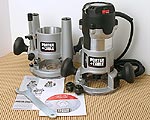 |
Porter Cable skipped updating the PC690, instead creating a new generation of routers that look to be the heir apparent for the industry standard title held by the 690's for years.
Click image to enlarge |
Porter Cable 893PK Router Package
Raising the standard, again
Text & Photos by Tom Hintz
Imagine you are on the engineering team that developed the venerable Porter Cable 690 series of routers. You know, the router by which all others were judged?
It's been a good run, but the other major router manufacturers are lobbing routers into the marketplace with more power and advanced features. It's getting crowded at the top and the time has come to re-invent what got you there.
Fortunately, Porter Cable was up to the task.
Initial Impressions
The PC 890 series routers retain the silver and black appearance, along with the traditional Porter Cable high quality casting and machining. Beyond the general look, the 890 series represents a major advancement in design. Porter Cable did not just freshen an old design; they built a new generation router loaded with new features.
As the pieces of the PC893PK kit come from their cases, they appear very well made with tight fitting seams enhanced by clean casting and molding processes. Though the temptation had to be strong to reduce costs by lowering the quality of materials or manufacturing, we found no evidence of either.
Instructions / CD
 |
The included CD has lots of good information that supports the instruction manual.
Click image to enlarge |
The multi-lingual instruction manual is adequate. Porter Cable provides a useful CD in the PC 893 kit that includes an electronic form of the instruction manual and a closer look at the many features, accessed by clicking on various areas of an interactive image of the PC890 router. Many of those pages lead to additional screens with more information on that and related features. Various links to areas of the Porter Cable web site are also provided.
The CD also has a video section in which Bob and Rick Rosendahl, hosts of The Router Workshop television program, demonstrate how to build the router table they use on their show. A plan set for the table is also included on the CD.
Motor
The motor was increased to 2 ¼ HP (12 amp) with a no-load operating range of 10,000 to 23,000 rpm. A state-of-the-art variable speed control, operated through a clearly marked dial, lets the operator accurately set the appropriate speed for the bit being used.
 |
The new motor features a dual-access switch. In the fixed base (not on the plunge base) the lower switch position is accessible at the handle level.
Click image to enlarge |
Also new is an electronic feedback system that stabilizes bit rpm during cutting, primarily in the low through middle speed ranges where you need it most. When cutting loads begin to slow the bit, the electronics sense this and automatically apply more power to maintain the selected bit speed.
RPM stabilizing circuits are less effective at high speeds where most of the available power is already being directed to the motor. The need for RPM stabilization at full speed is minimal. If a sharp bit and reasonable feed rates are used, RPM does not vary significantly.
A new inter-connected On/Off slider switch, accessible at the top of the motor and at handle level (fixed base only) allows starting and stopping the PC 890 while still gripping both handles. For those who forget to unplug the router during bit changes, the new On/Off switch is locked out anytime the spindle lock is depressed.
Note: The switch lockout is an additional safety feature that does not replace unplugging the router whenever working on or near the bit.
Spindle Lock
A simple, but effective spindle locking system has been added to the PC 890 motor that reduces bit changes to a one-wrench operation. The spindle lock button can be engaged manually with the motor out of the bases or with a flip-in actuator on the lower flange of the fixed
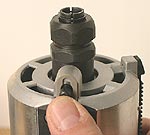 |
The new spindle lock makes bit changing a one-wrench deal. The new level-lock motor release makes removing it from the base for it changes a snap.
Click image to enlarge |
and plunge bases. Lower the motor so the collet is exposed below either base, turn the actuator in and turn the collet until the pin drops in the detent. Both hands are then free to hold the router and loosen the collet nut with the included wrench.
Note: When the base plate with the smaller hole (for guide collars) is installed on either base, the collet nut will not pass through it to allow changing bits outside of the base.
Collets
A welcome holdover from the 690 series is the self-extracting ¼" and ½" collet design. Install the bits approximately 1/16" to 1/8" from the bottom of the collet and removing them is never a problem. Loosen the collet nut, back it off a full turn or so until it feels tight again and a quarter-turn or so further pops the bit free. Short of having the bit pop out on command, I can't think of a way to improve this design. Apparently, the Porter Cable engineers are in agreement.
Lever Lock
Securing the motor in either the fixed or plunge base is as simple as flipping a finger-operated lever. The lever-locking feature on both bases has an adjusting screw with which the clamping force generated by the lever can be increased or decreased as needed.
Base Plates
The 890 series continues with the 5 ¾"-diameter base plates used on the 690 generation, including the same bolt pattern. The new base plates are made from clear plastic rather than black for better visibility. The fixed base is now equipped with a base plate with a 2 ½"-diameter hole to allow larger bits to be used. The base plate installed on the plunge base has the 1 3/16"-diameter hole, sized to accept the popular Porter Cable guide templets. The base plates can be swapped between the bases and with 690 series baseplates.
Handles
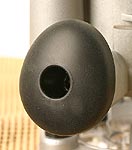 |
The new handle design and soft material bring a new comfort and feel of control.
Click image to enlarge |
The traditional round, black plastic handles have been given the ergonomic once-over and replaced by new egg-shaped soft-feel rubber versions that are remarkably comfortable to the hand. The new handles also give a solid feel of control and insulate the operator from what little vibration remains in the super-smooth motor.
If you use a router frequently, especially for long periods of time, the new handles will be an important improvement. For the more casual users, the new feel of control will be just as welcome.
Fixed Base
The fixed base has been redesigned to accommodate the second On/Off switch at the handle level. It also has a wider port for viewing the bit and surrounding area. Combined with the clear base, this new design gives the operator a much better field of vision for more accurate and safer routing.
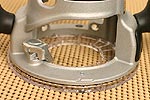 |
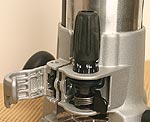 |
(Top) A wider opening and clear baseplate provide a much larger viewing area at the bit.
(Bottom) The lever-lock on the fixed base is augmented by both coarse and fine adjustment features that are easy and very fast to use.
Click images to enlarge |
The lever-locking system on the fixed base is augmented with a tab that when depressed disengages the mechanism from the gear rack on the motor housing for fast, coarse height adjustments.
Also new is a rack and pinion style system for making fine height adjustments. A soft grip knob with a graduated dial is used to make fine adjustments. The graduations are labeled in 1/64"-steps but have additional hash marks between each graduation allowing precise height changes of 1/128"! The overall range of adjustment is approximately 2 1/8" from full up to full down.
Because the fixed base is often used to hang the router in a table, the lever lock and fine adjustment features can be operated from above the table. Both have 3/16" hex drives that are accessible through holes in the base flange. Porter Cable sells an extended handle for this purpose or you can use a common 3/16" nut driver. A paper template is included in the PC 893 kit with which to lay out the bolt holes for hanging the fixed base and to locate the access holes for the height adjustments.
Plunge Base
Like the fixed base, the plunge version now sports the lever-lock system for securing the motor. The plunge base does not have the other height adjustment features found on the fixed base for obvious reasons.
|
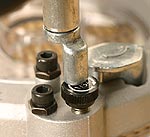 |
(Top) A comfortable knob at the top of the depth rod operates a rotating arm (Bottom) at it's end , selecting between three adjustable and one fixed stop positions.
Click images to enlarge |
Plunge depth is controlled by a rod system equipped with a traditional adjustable depth stop. A knob on top of the depth rod turns an arm at its bottom to select one of three adjustable and one blank position on the base flange. Having the rod itself turn rather than the traditional turret on the base flange makes it easier to change between pre-set plunge depths. One of the stops is finger-adjustable with each full revolution equating to a 1/32" height change.
The plunge release lever can be pushed into a detent at the end of its travel that locks the base in a free plunge mode. The angle of the plunge release lever in the locked position can be adjusted. The position of the free plunge detent is not adjustable.
A spindle lock arm is built into the base flange, used with the collet extended below the base plate. You can change bits with the plunge base in the "up" position by manually depressing the spindle lock button while loosening or tightening the collet nut. It is possible to damage the columns with the wrench this way, making it inadvisable. It is easier, and safer for the columns, to lock the plunge base down so the collet is extended below the baseplate or simply remove the motor from the base.
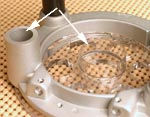 |
The plunge base comes with a shield that feeds dust to the cast-in port, sized for a 1" ID hose.
Click image to enlarge |
Note: The plunge base comes with a dust collection shield installed just above the clear base plate that helps direct dust to the collection port, sized to fit a 1" inside diameter hose or adapter. The instructions make no mention of this piece, though it is referenced on the CD in the interactive "Features" section.
The knurled nut on guide collars will fit inside the dust cover but the base plate must be removed to install and tighten the nut.
If the dust collection system is not being used, remove the dust cover and keep it in a safe place. Leaving this dust plate installed without a vacuum attached allows dust to quickly fill the gap between the dust and base plates, obscuring your vision somewhat.
Cases
 |
The stacking double cases protect the investment while giving you far more storage options in the smallest of shops.
Click image to enlarge |
The PC 893 kit comes packaged in a pair of interlocking cases. The cases join using a sliding dovetail molded into their ends. (Nice touch by the way.) Being able to stack or separate the cases gives you many more storage options, a very handy feature in modern space-challenged shops. The halves of one case can be joined, the bottom upside down to provide a "parking" platform for the router and a few tools.
The cases are identical, designed to hold the router in either base with places for collets, guide collars, tools and more. You may find yourself guessing which case contains the base you want to use. I took the easy way out and put a piece of duct tape on the case with the fixed base.
In The Shop
Any time a product is "improved" with a bunch of new features added, it sounds like a good thing. When it comes to woodworking tools, it is how the new version works in the shop that really counts. The Porter Cable 893PK router kit certainly looks great and the list of features is impressive, but to see how all this new stuff actually works when applied to wood, NewWoodworker.com put the PC 893 kit through its paces routing various profiles in several kinds of wood.
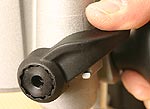 |
The adjustable plunge release lever is very easy to use and can be pushed into a detent for a free-plunge mode if desired.
Click image to enlarge |
One of the things I really liked about the 690 series routers was the handling and versatility. In the shop, the PC890 router handles as good as the 690 and more. The new grips and weight distribution gives the PC890 an even better feel of control than my 690's. The new grip design and material are certainly part of the reason, but the new motor is so smooth that it gives using the router an entirely different and better feel.
The combination of enlarged base openings and clear base plates has dramatically increased the operators view of what is going on at and around the bit. Routing up to or beginning at a specific line or mark has just gotten far more accurate. Because we use routers for decorative tasks so often, this is an important point.
The new 2 ¼ HP motor has new features beyond the increased power. The Soft Start circuitry is all but a given these days and a welcomed safety feature. The start-up kick of the old 1 ¾ HP wasn't all that tough to control but when dealing with 2 1/4 HP, employing Soft Start is just common sense.
The increased power of the PC890 motor, combined with the new variable speed control, makes it more useable in a router table, swinging a full range of bit diameters. The electronic feedback system is most effective in the low to moderate speed ranges and is most noticeable in table-mounted applications, turning larger bits at necessarily reduced speeds. Even with a 3"-diameter panel raising bit taking a heavier cut than I normally would, the feedback system maintained bit speed so well there was no perceptible loss.
 |
The gear rack can be removed (two screws) making the 890 series motor compatible with the 690 series bases.
Click image to enlarge |
The plunge base works well and the controls are nicely placed for easy use during routing. I especially like the idea of rotating the plunge rod arm from the top rather than having to turn the old-style turret at the base, near the bit.
The plunge motion is easy with sufficient resistance to maintain good feel and control. The plunge action is smooth when equal pressure is applied to both handles to avoid hanging up during the plunge. It should be noted that this is common to virtually all plunge routers and a technique that comes easily with a little practice.
The dust collection plate makes some bit changes difficult to do with the motor in the plunge base. This is a common trade-off with many routers. The new lever-lock system works so well that it is easier, and safer, to just slip the motor out of the base and change the bit on the bench when the profile allows.
The spindle lock is a welcome change that makes bit changing much easier than with the two-wrench system that preceded it.
All of the new features really shine when actually routing wood. The new motor is not only powerful; it is very smooth and surprisingly quiet. Through all routing operations I could think of there was no vibration felt, even with the motor dialed down to a speed range or two below what the bit actually needed. Crank it up to 23,000 RPM with a straight bit in the collet and that same smoothness continues.
The new motor is so quiet and smooth, I found myself checking the speed control dial to be sure it was actually turning as fast as I wanted. With several of my bits, I noticed what appeared to be a different sound during cutting. It turns out that sound comes from being able to hear the bit cutting the wood over the noise of the motor. I've never heard that before.
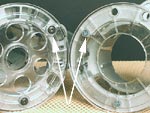 |
Different baseplate screws used on the bases is all I dislike about the PC893PK.
Click image to enlarge |
Dislikes
The only aspect of the new PC89PK kit that I don't like is that different style screws are used to attach the base plates to the plunge and fixed bases. The fixed base uses the normal Phillips-head screws but for some reason the plunge base came equipped with Torx (T20 bit size) screws. The Torx screws do have a slot cut in them for a flat-bladed screwdriver. Maybe there is a reason for the difference that I am not aware of, but using the same screws in both bases seems more logical if possible.
A small problem to be sure, and the only one I found.
Conclusions
The folks at Porter Cable have come through once again, elevating their position as the industry standard to a new high. The feature-laden PC893K router kit is not
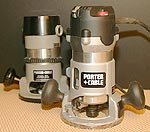 |
The 690 series (rear) is still a great router, but the 890's (front) will take their place as the industry standard.
Click image to enlarge |
only very capable, it is a great value for new and veteran woodworkers alike. The combination of power and an array of useful features make the PC890 series of routers exceptionally qualified for general router table tasks as well as all hand-held operations.
The PC890 series routers are built with the same quality design, materials and manufacturing that made the 690 series the standard by which all others were measured. The 690 remains a very good router, but I believe the PC890 routers will assume their rightful place at the top of the routing world and become Porter Cable's latest standard of the industry.
|
![]()















